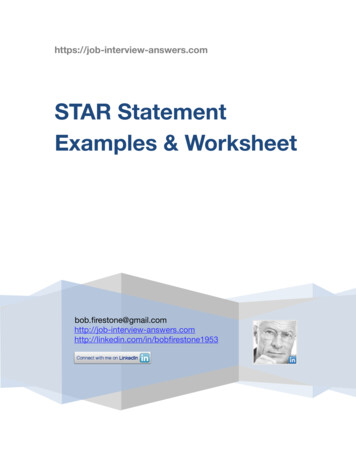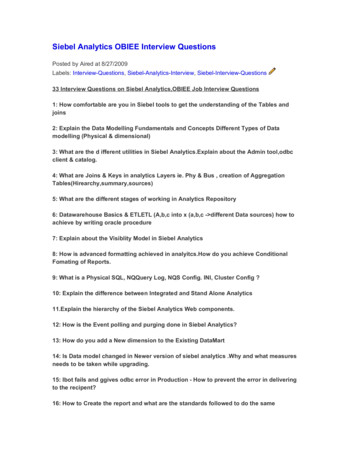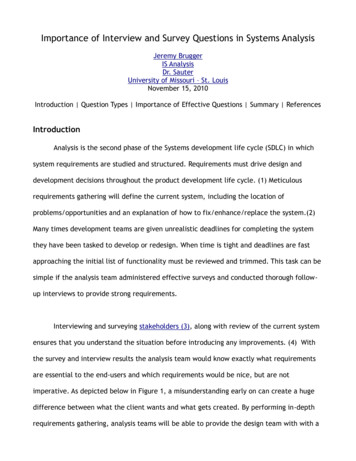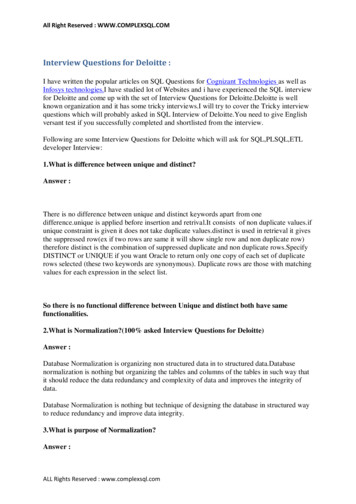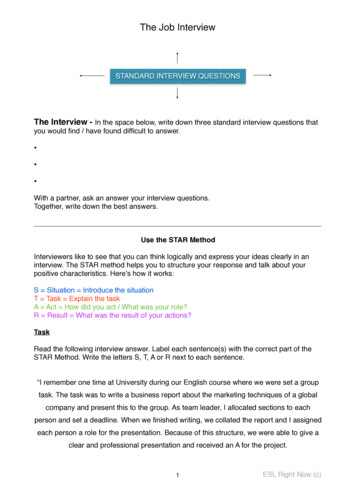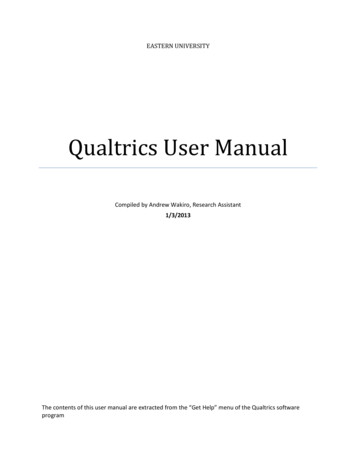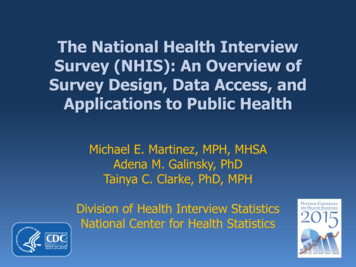
Transcription
The National Health InterviewSurvey (NHIS): An Overview ofSurvey Design, Data Access, andApplications to Public HealthMichael E. Martinez, MPH, MHSAAdena M. Galinsky, PhDTainya C. Clarke, PhD, MPHDivision of Health Interview StatisticsNational Center for Health Statistics
Objectives Describe how the NHIS is conducted Describe how to access NHIS data Describe NHIS sample design and weighting Provide an example of creating NHIS data files Provide examples of its use in health monitoring Discuss future directions and resources for learning
What is the NationalHealth InterviewSurvey (NHIS)?
The National Health InterviewSurvey (NHIS) Established by the 1956 National Health Survey Act,Public Law 652, 84th Congress Authorized as the National Health Survey First fielded in July, 1957
NHIS General Purposes Collect data on the health status and health careaccess of the U.S. non-institutionalized population Address specific issues of current public healthconcern Provide estimates for monitoring (Health UnitedStates, Healthy People program) 69 Healthy People 2020 Objectives
NHIS Interview Protocol In-person household interview survey With some telephone follow-up Interviews performed by trained U. S. CensusBureau interviewers Computer-assisted personal interviewing
NHIS Interview Protocol (cont.) Household respondent provides basic socio-demographicinformation on all members of household For each family within a household Aknowledgeable adult 18 or older responds forhim/herself and all other family members (FamilyRespondent)adult 18 or older (Sample Adult) and one child underage 18 (Sample Child) are randomly selected for moreextensive set of questions. The sample adult answers forhis/her self, while a knowledgeable adult answers for thechild. One
NHIS Structure: Basic ModuleFamily Core General information on all family membersFamily dataAllows proxy respondentsFielded each yearDemographicand generalhealth dataSample Adult Core Self-response onlyFielded each yearSample Child Core Knowledgeable adult responds for childFielded each yearHealthcondition,risk behavior,and healthbehavior data
NHIS Structure (cont.):Supplemental ModulesPurpose New topics or more detail on core topicsDifferent each yearMeet department goals/objectivesSponsors of supplements (examples):National Cancer Institute (NCI) United States Department of Agriculture (USDA) Office of the Assistant Secretary for Planning andEvaluation (ASPE) National Center for Environmental Health (NCEH)
Examples of NHIS Supplements Arthritis (2002, 2003, 2006,2009, 2014)Asthma (2002, 2008, 2013,2014)Balance/Dizziness (2008),2012, 2015)Complementary andAlternative Medicine (2002,2007, 2012)Cancer (2000, 2005, 2010,2015)Diabetes (2003, 2007)Disability (2002, 2008-present)Epilepsy (2010, 2013)Food Security (2011-present) Health InformationTechnology (2009, 2011-present) Health Insurance (2011-present) Immunization (2008-present)Hearing (2002, 2007, 2008), Heart Disease (2001, 2008, Medical Care Access andUtilization (2011-present)Mental Health (2001-2011, Occupational Health (2010, Oral Health (2008)Vision (2002, 2008)2014)2012, 2014)2013, 2014)2015)
NHIS Core Content Health conditions Health care access and utilization Health behaviors and risk factors Sociodemographic characteristics
AccessingNHIS Data
Where to Access NHIS Data?http://www.cdc.gov/nchs/nhis.htm
Where to Access NHIS Data?http://www.cdc.gov/nchs/nhis.htm
Questionnaires, Datasets and RelatedDocumentation, 1997-Present Survey SurveyDescription DocumentQuestionnaires Questionnaire Reference Guide English (Questionnaires and Flashcards) Spanish (Questionnaire and Flashcards) Field Representative Manual and Survey Informationon Co-Sponsors andSupplements Reports Data ReleaseFlowchart
2014 NHIS Data Release Foreach data file: Variablesummary Variable layout Variable frequencies ASCII data Sample SAS statements Sample SPSS statements Sample Stata statements
2014 NHIS Data Release Documentation Variablefor each data filesummary Variable layout Variable frequencies ASCII data Sample SAS statements Sample SPSS statements Sample Stata statements
2014 NHIS Data Release{
2014 NHIS Data ReleaseData files released for 2014: Family (FAMILYXX) Household (HOUSEHLD) Injury/Poisoning Episode (INJPOIEP) Person (PERSONSX) Sample Child (SAMCHILD) Sample Adult (SAMADULT) Imputed Income Files (INCMIMP1-INCMIMP5) Paradata (PARADATA) Family Disability Questions Tests (FMLYDISB) Functioning and Disability (FUNCDISB)(File names shown in parentheses)
Creating an NHIS Data File:Some Considerations
NHIS Sample Design Complex Important totake into accountwhen computingvarianceestimates
Sampling Weights Each file has its own sampling weight Weights should be used for all analyses Weights are used to inflate each observation Weights are adjusted for non-response, oversampling, and most are calibrated to U.S. Censuspopulation estimates by age, sex, and race/ethnicity If weights are not used: Percentages, means, and proportions will be affectedEstimates such as regression coefficients may be biased
Weighting Example:Race/Ethnicity of Persons 18-64 Years,NHIS 2013Race/EthnicityUnweighted (%)Weighted (%)Hispanic21.816.5NH white54.964.4NH black14.712.6NH Asian7.35.6NH all other races1.30.9Note: NH non-Hispanic.
Sample Design Variables Consequences of not accounting for sampledesign when calculating variance Standarderrors will be, on average, too small andconfidence intervals too narrow More Type I error To obtain accurate variance estimates, use theNHIS design variables in your analysis toaccount for the NHIS complex sample design
Using Weights and Sample Design Variables, Example:Average Number of Days in Bed Due to Illness/Injury forNH White and NH Black Adults 18-64 Years, NHIS 2012NHISUnweightedNHISWeightedNHIS 5.594.104.884.104.88Std. -1.52p-value0.0040.0460.130Note: NHW non-Hispanic white; NHB non-Hispanic black.
Variables to Include in Your Analytic File1.Study variables2.Weight variable(s)3.Sample design variables STRAT P and PSU P (2006-Present)STRATUM and PSU (1997-2005)
Which Weight Do I Use? Person file WTFASample Adult file .WTFA SASample Child file .WTFA SCHousehold file: WTFA HHFamily file: WTFA FAM
Creating the File:Example Research QuestionIs there a relationship betweenthe health insurance status of adults andunmet medical needs due to cost?
Creating the File:Data File Information Available Survey Description Document File documentation (i.e., layout, summary,unweighted frequencies) Data SAS, SPSS, and Stata input statements Questionnaire (English and Spanish) Interviewer’s Manual
Creating the File:Creating a Formatted File from Raw Data The NHIS data and SAS, SPSS, and Stata programsare available from the NHIS website(http://www.cdc.gov/nchs/nhis.htm). Programs can be used to create datasets withvariable formats and labels Each data file (e.g., Person, Sample Adult) has itsown SAS, SPSS, and Stata program
Creating the File:Identifying the Files You Need Variables are in different files Health insurance (Person file)Unmet medical needs (Sample Adult files)Must merge Person and Sample Adult files
Creating the File:Identifying the Files/Variables You Need Person file variables: Identifiers: household number (HHX), familynumber (FMX), and person number (FPX) Healthinsurance (NOTCOV) Designvariables (STRAT P and PSU P)
Creating the File:Identifying the Files/Variables You Need Sample Adult file variables Identifiers:household number (HHX), familynumber (FMX), and person number (FPX) Needed,but could not afford and did not receiveany of the following in the past 12 months: Prescriptionmedications (AHCAFYR1) Mental health care or counseling (AHCAFYR2) Dental care (including check-ups) (AHCAFYR3) Eyeglasses (AHCAFYR4) SampleAdult sampling weight (WTFA SA)
Creating the File:Identifying the Files/Variables You Need Weight chosen depends on the unit of analysis The population of interest In what data file the mainlocatedoutcome of interest is
Creating the File:Merging Files Together To merge the Person and Sample Adult files, use thehousehold number (HHX), family number (FMX), andperson number (FPX) Note the name of the person number variable has changed: FPX (2004-Present)PX (1997-2003)Example merging code can be found in The Survey Description Document
Creating the File:Merging Files TogetherSampleAdultFile PersonFile Adults whoare notSampleAdults,andall childrenSampleAdults
Creating the File:Merging Files TogetherSampleAdultFile PersonFile DROP?NO!Adults whoare notSampleAdults,andall childrenSampleAdults
Creating the File:Subpopulation Analysis Can produce correct point estimates usingappropriately weighted subsetted data. But Must retain design variable information for allrecords to obtain correct variance estimates To obtain estimates for a subpopulation, use theappropriate statistical software procedures: SUBPOP (Stata)SUBPOPN (SUDAAN)DOMAIN (SAS)
Creating the File:Subpopulation Analysis For more specific information, seeThe Survey Description Documentftp://ftp.cdc.gov/pub/Health Statistics/NCHS/Dataset Documentation/NHIS/2014/srvydesc.pdf
Creating the File:Summary The NHIS data are released as multiple data files thatcan be merged together Use the documentation to identify which files havethe variables you need Be sure to get the design variables and weightvariable from the appropriate files Use appropriate statistical software to use theweights and the sample design variables to obtainaccurate, unbiased point estimates and varianceestimates
Examples using the NHIS
Stephen J. Blumberg, Ph.D., Tainya C. Clarke, Ph.D.,Debra L. Blackwell, Ph.D.,Racial and EthnicDisparities in Men's Use ofMental Health Treatments.NCHS data brief, no 206. Hyattsville, MD: National Centerfor Health Statistics. 2015.
This report used nationally representative data on thefrequency of mental health symptoms and relatedtreatment utilization to compare men of color withnon-Hispanic white men. Men of color included non-Hispanic black andHispanic men. It also explored whether racial and ethnic disparitiesdiffer by age, health insurance coverage status, andincome.
Methods Men aged 18 and over (n 21,058) We pooled data from 2010 -2013 to get a large enoughsample size for our outcome of interest. Mental health and medication use data came from theQuality of Life (QOL) and the Adult Functioning andDisability (AFD) supplements to sample adult NHIS. Demographic and other health information (includinghealth insurance coverage) were collected in the Corecomponents of NHIS. We used a special sample adult weight on thesupplemental files because our outcome of interestcame from this file and we generalized our findings tothe US adult population.
Figure 1-1. Percentage of men aged 18 and over with dailyfeelings of anxiety or depression, by race and ethnicity:United States, 2010-2013PercentAll races and ethnicities10987654321017.7Non-Hispanic whiteNon-Hispanic black or Hispanic8.58.23.51Significantly different from9.07.36.6Daily feelings of anxiety113.82.9Daily feelings ofdepressionnon-Hispanic black and Hispanic men.SOURCE: CDC/NCHS, National Health Interview Survey, 2010-2013.Daily feelings of anxietyor depression
Figure 1-2. Percentage of men aged 18 and over with dailyfeelings of anxiety or depression, by age and race and ethnicity:United States, 2010-2013PercentAll races and ethnicities109876543210Non-Hispanic white9.4218.59.216.145 years and overmen aged 45 and over in the same race and ethnicity group.non-Hispanic black and Hispanic men in the same age group.SOURCE: CDC/NCHS, National Health Interview Survey, 2010-2013.2Significantly different from9.47.618-44 years1Significantly different fromNon-Hispanic black or Hispanic
Figure 1-3. Percentage of men who took medication or talked toa mental health professional, among men aged 18-44 who feltanxious or depressed every day, by health insurance coveragestatus, income, and race and ethnicity:United States, 2010-2013Non-Hispanic whiteNon-Hispanic black or *2051.212.7100UninsuredInsuredHealth insurance coverage statusIncome 200% FPL Income 200% FPLAnnual income relative tothe federal poverty level (FPL)
Tainya C. Clarke, Ph.D., Lindsey I. Jones, M.P.H.,Barbara J. Stussman, B.A., Patricia M. Barnes, M.A.,Richard L. Nahin, Ph.D.Trends in the Use ofComplementary Health ApproachesAmong Adults: United States,2002 – 2012National health statistics reports; no 79. Hyattsville, MD:National Center for Health Statistics. 2015.
This report presented national estimates of the useof complementary health approaches among adults inthe United States across three time points. Complementary health approaches include an arrayof modalities and products with a history of use ororigins outside of conventional Western medicine. Findings were generalized to the noninstitutionalizedUS adult population.
Methods The study sample included 88,962 US adults aged 18and over. The study used data from 2002, 2007 and 2012 to lookat differences in use within the population over time. Data on use of complementary health approaches camefrom the Alternative Health (ALT) supplements tosample adult NHIS. Demographic and other health information (e.g. ageand gender) were collected in the Core components ofNHIS. We used the sample adult weight because that weightwas also used in the ALT supplement and wegeneralized our findings to the US adult population.
Figure 2-1. Trend in the use of common complementary healthapproaches among US adults in the past 12 months:United States, 201212.710.910.15.86.7Nonvitamin,Deep breathingYoga, tai chi, qinonmineral dietaryexercisesgongsupplements(independently or (independently oras a part of otherin a class)approaches)7.58.6 8.48.36.95.0Chiropractic orosteopathicmanipulationMassage
In summaryWe can use A single year of NHIS data to answer a particularresearch question Combine core files and or supplements within a year togain detailed information on specific topics. Combine years to get a large enough sample size Combine years to look at trends over time
What’s Next for theNHIS?
Selected 2015 NHIS SupplementsTopicSponsorCancerNCIHeart Disease and StrokeCDC/DHDSP, NIH/NHLBI, NIH/NINDSTobacco UseFDAFood SecurityUSDAEnhanced Questions on Health CareAccess and UtilizationDHHS/ASPEAdult and Child ImmunizationCDC/NCIRDChild Mental Health Brief SDQSAMHSA/CMHS
Additional Future Plans for the NHIS Sample redesign in 2016 Content redesign in 2018 Online Analytic Real-time System (OARS) tool for usewith restricted in-house and public use dataNew (to NHIS) modes of data collection
How to Learn Moreabout the NHIS:Where to Go for Help
Navigating the NHIS Website
Reports and Products Microdata files, questionnaires, related productsAnnual reports of estimates (Summary Health Statistics) Population, Children, and AdultsEarly Release Program Key Health Indicators, Health Insurance, Access andUtilization, Wireless Substitution Quick Stats Data Briefs National Health Statistics Reports
Research Data Center (RDC) taType/Dt1225.htm List of public use and restricted variables on data files Submit process application for research project Application is reviewed by RDC for approval to proceed Fee rdca@cdc.gov
Strengths of andChallengesFacing the NHIS
Strengths of the NHIS Large, nationallyrepresentative sample Household and familybased survey In-person survey Broad range ofinformation Demographic detail Ongoing annual survey Topical supplementaryinformation Relatively high responserates Links to other data sets Timely release
Challenges Facing the NHISTechnological changes taconfidentiality andsecurity issuesRespondentburdenBetter data on thehealth of the nationSurveyfunding/costHard-to-reachpopulations
For More Information:To keep up with new developments, subscribe to the NHIS Listserv:http://www.cdc.gov/nchs/nhis/nhis listserv.htmDivision of Health Interview StatisticsNational Center for Health Statistics3311 Toledo RDHyattsville MD 20782
NHIS Interview Protocol (cont.) Household respondent provides basic socio-demographic information on all members of household For each family within a household A knowledgeable adult 18 or older responds for him/herself and all other family members (Family Respondent) One adult 18 or older (Sample Adult) and one child under age 18 (Sample Child)are randomly selected for more

